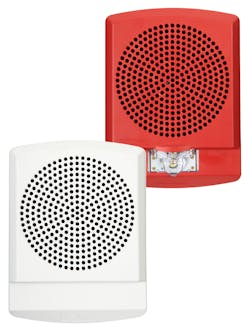Fire & Life Safety: Low Frequency Sounders
A new type of audible notification signal was introduced in the 2012 version of NFPA 72 that employs a low-frequency sound — in the 520 Hz range — when appliances are installed where people sleep.
If installing a fire alarm system in a residence, and the homeowner indicates to you that they are hearing impaired, then the sounders you install must provide the 520 Hz tone. Since 2014, their use is required in residential commercial occupancies where people sleep — such as in hotel/motel guest rooms, and in apartment bedrooms and guest bedrooms (i.e. living rooms).
Even when an Emergency Voice Alarm Communication (EVAC) system is used to alert occupants in sleeping areas of commercial buildings, the alert signal must include the 520 Hz component.
What brought about this new requirement? A few years ago, two special studies were completed that looked at “the effectiveness of fire alarm systems” to determine if improvements could be made that would better alert those impaired by alcohol and for “adults who are hard of hearing.” The results of the studies indicated, not surprisingly, that sounders that provided a low-frequency component increased effectiveness — a sound that is missing from current systems that provide audible notification from piezo sounders.
A little back story here may prove helpful to better understand the course of events that brought these studies about. Thirty years ago, before ADA requirements were applied to fire alarm system installations, the fire horns that provided notification commonly used a large electromagnetic coil to make an interior disc vibrate. The resulting sound seemed very loud and easily penetrated walls and doors. Older fire alarm systems had no requirements for battery backup, and their horns were often 120 volts or lower and AC powered.
After the battery back-up power requirements began, systems also had to include visual notification appliances, such as strobe lights, to meet ADA requirements. These combined provisions caused a transformation in how fire alarm systems were designed.
Piezo Devices
To lower power consumption and costs, electronic appliances became the popular audible component, and electromagnetic coils became old-school. Systems just could not be designed to handle the electrical power needed, so, similar to how DC transistors replaced relays and AC coils, these power-hungry mechanical sounders were replaced with small, efficient piezo devices.
The piezo appliances used a very small amount of current to excite its components to create a higher frequency noise. While they were measured with a decibel meter to be within the volume or sound level prescribed by code for “public mode and private mode signaling,” they just did not seem the same. They were missing the lower frequency sounds that could rattle your teeth and cause you to back down your ladder a rung or two when they were being adjusted.
The code at that time only stated volume, not tone. Even though piezo sound levels were in compliance, more were typically installed to better distribute the alarm signal to all parts of the building. Piezo technology was also necessary to off-set the high current draw required of the now mandated ADA strobe lights.
Strobe Light Requirements
Some readers may recall that the first years of the strobe light requirements mandated their use for waking hearing-impaired persons in “sleeping areas” (originally known as ‘bedrooms’). Since sleeping areas required 177 cd strobe lights when installed on the ceiling, these brighter strobes only ran on 120 VAC. Like the audible appliances before them, the evolution of these strobe lights to appliances with lower current draws/voltage was slow.
In the early days of ADA, you would use a relay in the sleeping room to activate the 120 VAC strobe lights. Today, technology has advanced to where we can easily support 24 VDC strobes many times brighter than the 120 VAC 177 cd models.
Cost Considerations
It seems the “advances” in technology have come full circle — to the point where the codes are now beginning to recognize that tone, not just volume, matters to the overall effectiveness of our fire alarm systems.
But the question begs to be asked: “If the low frequency appliances are more effective, why are they not being required everywhere?” Practically speaking, the piezo technology is smaller, cheaper, lighter and uses less power than their low-frequency predecessors. And the new low-frequency appliances are larger, more costly and use more power.
Therefore, for now, the codes only require low-frequency usage where people sleep. Would a more effective audible fire alarm signal be welcome in every part of all buildings? Of course! But until the size and cost of these new low-frequency appliances comes down, along with their electrical power requirements, they will only be voluntarily used in non-sleeping areas.
Greg Kessinger is SD&I’s fire alarm and codes expert and a regular contributor. Email him your fire & life safety questions at [email protected].


